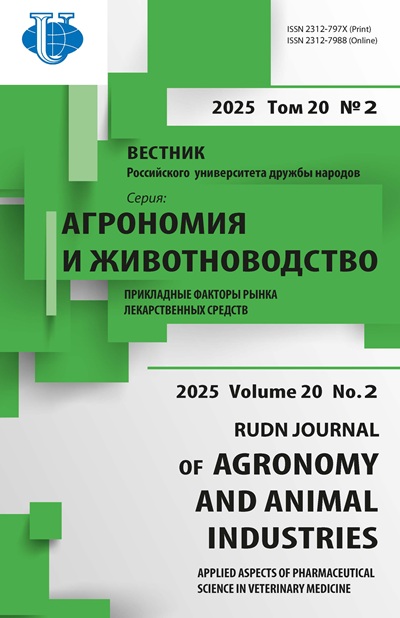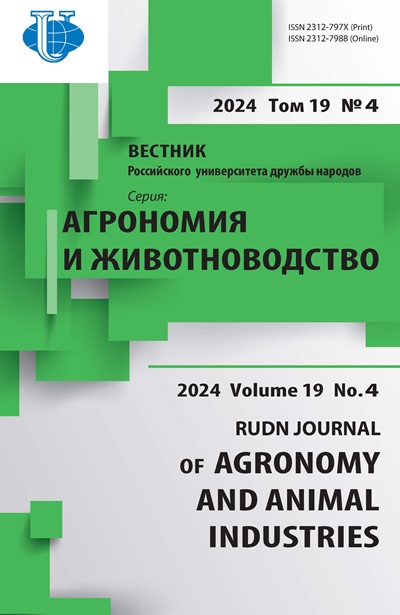Control of the postoperative condition of cats with unilateral ureteral obstruction
- Authors: Lust V.A.1,2, Scheidt G.E.1,2
-
Affiliations:
- RUDN University
- AlisaVet veterinary clinics network
- Issue: Vol 19, No 4 (2024)
- Pages: 696-706
- Section: Veterinary science
- URL: https://agrojournal.rudn.ru/agronomy/article/view/20135
- DOI: https://doi.org/10.22363/2312-797X-2024-19-4-696-706
- EDN: https://elibrary.ru/CUHTEM
- ID: 20135
Cite item
Full Text
Abstract
Treatment of acute postrenal ureteral obstruction is a rather complicated, but extremely necessary process. It includes both surgical techniques to resolve the obstruction, and drug treatment, which largely affects the patient’s recovery period. The main goal in the postoperative period is to reduce the indicators of azotemia in these patients. Its main aspects are liquid therapy, antibiotic therapy and alpha 1‑adrenoblockers to relax the smooth muscle of the urethra. The objective of the research was to study how the replacement of ¼ of the total volume of crystalloid solutions in liquid therapy, calculated according to the formula of deficient and supportive volume, with colloidal solutions and blood plasma affects the restoration of blood parameters in the postoperative period; how an increase in the volume of oncotic pressure affects the effectiveness of reducing azotemia in patients in the postoperative period. 3 groups of 3 patients with createnine values in the range of 700–1000 mmol/L were selected. All underwent surgery in the form of ureteral reimplantation, which resolved the cause of the obstruction. Further, blood counts were monitored on DRI-CHEM NX500 analyzers and the Heska Element HT5 general clinical analyzer for 14 days after surgery and on 3,5,7,14 days from the date of observation. All groups showed a decrease in azotemia. However, there were differences in the effectiveness of the reduction. Patients receiving a crystalloid solution showed the most effective reduction of azotemia, unlike patients receiving liquid therapy, which includes protein inclusions. However, liquid therapy with blood plasma in the protocol showed a slightly better decrease than with colloidal solution. We conclude that drugs containing protein inclusions are not the drugs of choice in the case of correction of the condition in cats with benign unilateral ureteral obstruction.
Full Text
Fig. 1. Ureter (visualizing the ureter in the retroperitoneal space)
Source: photo by V.A. Lust.
Fig. 2. Transected ureter proximal to the obstruction site
Source: photo by V.A. Lust.
Fig. 3. U-shaped flap from the wall of the urinary bladder (a flap from the wall of the urinary bladder in which holes are made and the end of the ureter is inserted from the outside)
Source: photo by V.A. Lust.
Fig. 4. Anastomosis of the urinary bladder and ureter according to Boari (the ureter is sutured from the inner side of the urinary bladder and the U-shaped flap is sutured with a tube)
Source: photo by V.A. Lust.
Dynamics of blood parameters in the postoperative period
Parameter | Day | FI | Animal groups M ± m | ||
Group I | Group II | Group III | |||
Urea, mmol/L | Before surgery | 3.28…10.24 | 31.5 ± 2.1 | 32.0 ± 1.2 | 31.0 ± 1.3 |
After surgery | 24.2 ± 2.8 | 23.8 ± 2.0 | 27.6 ± 1.3 | ||
3 | 20.1 ± 0.1 | 20.8 ± 2.0 | 22.6 ± 2.8 | ||
5 | 19.0 ± 0.5 | 19.3 ± 0.2 | 20.8 ± 3.0 | ||
7 | 16.6 ± 1.7 | 16.7 ± 1.6 | 18.1 ± 2.1 | ||
14 | 13.3 ± 1.7 | 14.5 ± 1.4 | 16.7 ± 1.5 | ||
Creatinine, μmol/L | Before surgery | 35…124 | 853.5 ± 70.0 | 942.1 ± 16.9 | 930.0 ± 32.8 |
After surgery | 396.0 ± 36.0 | 422.9 ± 29.8 | 489.2 ± 10.6 | ||
3 | 291.6 ± 13.1 | 309.9 ± 5.2 | 354.5 ± 6.1 | ||
5 | 219.1 ± 27.5 | 245.2 ± 25.9 | 257.7 ± 10.3 | ||
7 | 145.9 ± 12.1 | 151.7 ± 4.8 | 189.3 ± 11.1 | ||
14 | 85.8 ± 5.9 | 114.5 ± 10.7 | 122.8 ± 14.6 | ||
Hematocrit, ht | Before surgery | 0.29…0.45 | 35.9 ± 6.9 | 27.3 ± 0.7 | 27.3 ± 0.7 |
After surgery | 27.6 ± 4.9 | 26.7 ± 2.4 | 24.7 ± 1.3 | ||
3 | 28.4 ± 2.5 | 25.7 ± 2.5 | 25.7 ± 1.3 | ||
5 | 30.9 ± 3.8 | 25.1 ± 1.7 | 27.0 ± 1.7 | ||
7 | 34.0 ± 2.5 | 26.2 ± 2.9 | 28.3 ± 0.9 | ||
14 | 31.1 ± 1.8 | 28.3 ± 2.2 | 29.3 ± 1.0 | ||
Erythrocytes, million/μl | Before surgery | 5.0…10.0 | 8.7 ± 1.5 | 7.3 ± 0.5 | 6.8 ± 0.8 |
After surgery | 6.7 ± 0.7 | 6.7 ± 0.3 | 6.1 ± 0.7 | ||
3 | 6.4 ± 1.8 | 6.5 ± 0.7 | 6.5 ± 0.6 | ||
5 | 7.8 ± 1.2 | 6.7 ± 0.8 | 6.8 ± 0.5 | ||
7 | 8.9 ± 1.1 | 6.8 ± 0.8 | 7.2 ± 0.3 | ||
14 | 9.0 ± 0.5 | 7.4 ± 0.6 | 7.6 ± 0.5 | ||
Hemoglobin, g/L | Before surgery | 90…150 | 118.6 ± 14.4 | 116.1 ± 11.4 | 116.0 ± 11.3 |
After surgery | 91.4 ± 9.1 | 98.8 ± 1.5 | 100.5 ± 1.8 | ||
3 | 88.3 ± 9.0 | 89.4 ± 2.2 | 86.6 ± 5.3 | ||
5 | 89.8 ± 8.1 | 87.1 ± 3.1 | 82.0 ± 8.4 | ||
7 | 100.8 ± 1.4 | 88.1 ± 2.7 | 87.0 ± 2.9 | ||
14 | 123.5 ± 2.7 | 103.1 ± 3.0 | 92.9 ± 2.2 | ||
Leukocytes, thousand/μl | Before surgery | 6…18 | 10.1 ± 0.5 | 10.0 ± 1.1 | 10.8 ± 0.3 |
After surgery | 12.1 ± 1.2 | 11.1 ± 0.9 | 11.5 ± 0.7 | ||
3 | 11.7 ± 0.7 | 10.8 ± 0.6 | 11.2 ± 0.9 | ||
5 | 12.2 ± 2.0 | 11.7 ± 0.7 | 11.3 ± 0.2 | ||
7 | 14.6 ± 1.2 | 10.6 ± 0.6 | 11.3 ± 0.2 | ||
14 | 12.2 ± 0.4 | 10.5 ± 0.6 | 11.3 ± 0.8 | ||
Note. FI is a physiological indicator; p < 0.05 in relation to FP.
Source: completed by V.A. Lust.
About the authors
Vladislav A. Lust
RUDN University; AlisaVet veterinary clinics network
Author for correspondence.
Email: 1142220008@pfur.ru
ORCID iD: 0009-0003-7605-120X
postgraduate student, RUDN University; veterinary surgeon, ʺAlisaVetʺ veterinary clinics network
6 Miklukho-Maklaya st., Moscow, 117198, Russian Federation; 17 Chobotovskaya st., bldg. 1, Moscow, 119634, Russian FederationGrigory E. Scheidt
RUDN University; AlisaVet veterinary clinics network
Email: 1032190635@pfur.ru
ORCID iD: 0009-0005-5312-8950
postgraduate student, RUDN University; veterinary surgeon, ʺAlisaVetʺ veterinary clinics network
6 Miklukho-Maklaya st., Moscow, 117198, Russian Federation; 17 Chobotovskaya st., bldg. 1, Moscow, 119634, Russian FederationReferences
- Clarke DL. Feline ureteral obstructions Part 1: medical management. J Small Anim Pract. 2018;59(6):324—333. doi: 10.1111/jsap.12844
- Berent AC, Weisse CW, Todd KL, Bagley DH. Use of locking-loop pigtail nephrostomy nephrostomy catheters in dogs and cats: 20 cases (2004–2009). Journal of the American Veterinary Medical Association. 2012;241(3):348—335. doi: 10.2460/javma.241.3.348
- Holloway A, O’Brien, R. Perirenal effusion in dogs and cats with acute renal failure. Veterinary Radiology & Ultrasound. 2007;48(6):574—579. doi: 10.1111/j.1740-8261.2007.00300.x
- Myburgh, JA, Finfer S, Bellomo R, Billot L, Cass A, Gattas D, et al. Hydroxyethyl starch or saline for fluid resuscitation in intensive care. The New England Journal of Medicine. 2012;367(20):1901—1911. doi: 10.1056/NEJMoa1209759
- Widmer WR, Biller DS, Adams LG. Ultrasonography of the urinary tract in small animals. Journal of the American Veterinary Medical Association. 2004;225(1):46—54. doi: 10.2460/javma.2004.225.46
- Guidet B, Martinet O, Boulain T, Philippart F, Poussel JF, Maizel J, et al. Assessment of hemodynamic efficacy and safety of 6 % hydroxyethylstarch 130/0.4 vs. 0.9 % NaCl fluid replacement in patients with severe sepsis: the CRYSTMAS study. Critical Care. 2012;16: R94. doi: 10.1186/cc11358
- Langston C, Eatroff A. Acute kidney injury. In: Silverstein DC, Hopper K. (eds.) Small Animal Critical Care Medicine. 2nd ed. St Loius, MO, USA: Saunders Elsevier; 2015. p.665—660.
- Clarke DL. Feline ureteral obstructions Part 2: surgical management. Journal of Small Animal Practice. 2018;59(7):385—397. doi: 10.1111/jsap.12861
- Kyles AE, Hardie EM, Wooden BG, Adin CA, Stone EA, Gregory CR, et al. Clinical, clinicopathologic, radiographic, and ultrasonographic abnormalities in cats with ureteral calculi: 163 cases (1984–2002). Journal of the American Veterinary Medical Association. 2005;226(6):932—936. doi: 10.2460/javma.2005.226.932
- Snow SJ, Ari Jutkowitz LA, Brown AJ. Retrospective Study: Trends in plasma transfusion at a veterinary teaching hospital: 308 patients (1996—1998 and 2006—2008). J Vet Emerg Crit Care. 2010;20(4):441—445. doi: 10.1111/j.1476-4431.2010.00557.x
- Wormser C, Clarke DL, Aronson LR. Outcomes of ureteral surgery and ureteral stenting in cats: 117 cases (2006–2014). Journal of the American Veterinary Medical Association. 2016;248(5):518—525. doi: 10.2460/javma.248.5.518
- Achar E, Achar RA, Paiva TB, Campos AH, Schor N. Amitriptyline eliminates calculi through urinary tract smooth muscle relaxation. Kidney International. 2003;64(4):1356—1364. doi: 10.1046/j.1523-1755.2003.00222.x
- Zobbea VB, Rygaard H, Rasmussen D, Strandberg C, Krause S, Hartsen SH, et al. Glucagon in acute ureteral colic. European Urology. 1986;12(1):28—31. doi: 10.1159/000472572
- Jones JM, Burkitt-Creedon JM, Epstein SE. Treatment strategies for hyperkalemia secondary to urethral obstruction in 50 male cats: 2002—2017. Journal of Feline Medicine and Surgery. 2022;24(12): e580 e587. doi: 10.1177/1098612X221127234
- White C, Stifelman M. Ureteral Reimplantation, Psoas Hitch, and Boari Flap. J Endourol. 2020;34(S1): S25–S30. doi: 10.1089/end.2018.0750
- Concannon KT. Colloid oncotic pressure and the clinical use of colloidal solutions. Journal of Veterinary Emergency and Critical Care. 1993;3(2):49—62. doi: 10.1111/j.1476-4431.1993.tb00102.x
Supplementary files
Source: photo by V.A. Lust.
Source: photo by V.A. Lust.



















